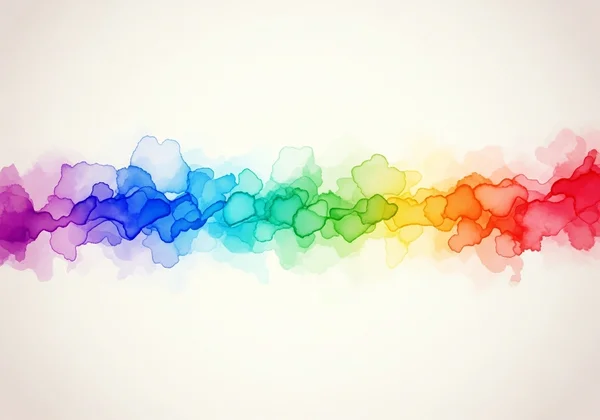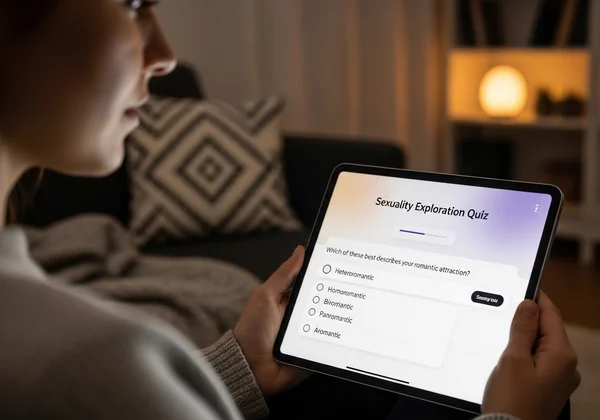Qual è la mia sessualità? Una guida gratuita al test sulla sessualità
Interrogarsi sulla propria sessualità può essere un'esperienza confusa, eccitante e un po' travolgente, ed è una parte completamente normale della scoperta di sé. Se ti sei ritrovato a chiederti: Qual è la mia sessualità?, hai compiuto un coraggioso primo passo in un viaggio personale. Questa guida è qui per offrirti uno spazio sicuro e privo di giudizio per esplorare questa domanda. Ti presenteremo un test sulla sessualità gratuito che può aiutarti a riflettere sulle tue attrazioni uniche e a iniziare a trovare chiarezza.
Questo viaggio è solo tuo, e non esiste un modo giusto o sbagliato di sentire. L'obiettivo non è trovare un'etichetta restrittiva, ma comprendere meglio te stesso. Per molti, trovare un linguaggio che risuoni con i propri sentimenti può essere potenziante e affermativo. Pensa a questo processo come a un modo per conoscere la versione più autentica di te stesso. Se sei pronto a esplorare, il nostro test gratuito sulla sessualità è disponibile per guidare la tua riflessione.
Comprendere il tuo orientamento sessuale
Prima di immergerti nell'auto-riflessione, è utile comprendere alcuni concetti fondamentali. Per decenni, la psicologia si è allontanata da definizioni rigide della sessualità, riconoscendola come un aspetto profondamente personale e sfaccettato di chi siamo. Sottoporsi a un test di orientamento sessuale non significa ottenere un punteggio finale, ma avere un momento guidato per considerare queste diverse sfaccettature della propria esperienza.

La sessualità è uno spettro, non una scatola
Una delle idee più liberatorie della psicologia moderna è quella dello spettro della sessualità. Invece di vedere la sessualità come un insieme di categorie distinte come "gay" o "etero", è più utile vederla come uno spettro ampio e colorato. Alcune persone potrebbero trovarsi a un'estremità, mentre molte altre si collocano in qualche punto intermedio, e alcune potrebbero non essere affatto sullo spettro (come nel caso dell'asessualità).
Questo concetto convalida le esperienze di tanti che sentono di non rientrare perfettamente in una singola categoria. Potresti sentirti prevalentemente attratto da un genere ma occasionalmente provare sentimenti per un altro. Oppure potresti scoprire che il genere di una persona non è affatto il fattore primario nella tua attrazione. Tutto ciò fa parte della naturale diversità dell'attrazione umana, e comprendere questo spettro può rimuovere la pressione a conformarsi a una semplice etichetta.
Componenti chiave: Attrazione, Comportamento e Identità
Per comprendere la tua sessualità, è utile scomporla in tre componenti correlate ma distinte. L'esperienza di una persona è una combinazione unica di questi elementi, che non sempre si allineano perfettamente.
- Attrazione: Questo è chi ti attrae emotivamente, romanticamente o sessualmente. Riguarda i tuoi sentimenti interni, le fantasie e i desideri. Puoi anche avere diversi tipi di attrazione, come l'attrazione romantica (con chi vuoi avere una relazione romantica) e l'attrazione sessuale (chi desideri sessualmente).
- Comportamento: Questo si riferisce alle tue azioni ed esperienze. Con chi hai avuto relazioni o incontri sessuali? È importante sottolineare che il comportamento non definisce l'orientamento. Qualcuno che ha frequentato solo persone del sesso opposto può comunque identificarsi come bisessuale o queer.
- Identità: Questa è l'etichetta che scegli per te stesso (ad esempio, lesbica, bisessuale, pansessuale, etero, asessuale). I risultati del tuo test di identità sessuale sono un riflesso dei tuoi sentimenti, ma tu sei l'autorità ultima sulla tua identità. È una scelta personale basata su ciò che ti sembra più vero.
Va bene che i tuoi sentimenti siano fluidi
La sessualità può essere fluida, il che significa che può cambiare ed evolvere nel tempo. Il modo in cui ti senti a 18 anni potrebbe essere diverso da come ti senti a 25 o 40. Questo non invalida i tuoi sentimenti passati o presenti; riflette semplicemente che, man mano che cresciamo e facciamo nuove esperienze, la nostra comprensione di noi stessi può approfondirsi e mutare.
Molte persone scoprono che le loro attrazioni cambiano man mano che imparano di più su se stesse e il mondo. Abbracciare la fluidità significa darsi il permesso di essere un lavoro in corso. Il tuo processo di auto-comprensione non è una corsa verso una destinazione fissa.
Come trovare la tua sessualità: Passi pratici
Ora che abbiamo trattato alcune idee fondamentali, come si esplora attivamente la domanda: "Qual è la mia sessualità?" La risposta sta in una riflessione onesta e delicata e nella raccolta di informazioni da fonti affidabili. Ecco alcuni passi pratici che puoi intraprendere.
Riflettere sulle tue attrazioni personali
Metti da parte un po' di tempo tranquillo per pensare, senza giudizio. Considera le seguenti domande come punti di partenza per il tuo diario o i tuoi pensieri:
- Chi mi attrae nei film, nei libri o nella vita reale?
- Quando immagino una relazione romantica appagante, che aspetto ha?
- Provo attrazione sessuale, attrazione romantica o entrambe? Come differiscono per me?
- Le mie attrazioni sono coerenti o cambiano a seconda della persona o della situazione?
Non ci sono risposte giuste qui. L'obiettivo è semplicemente osservare il tuo mondo interiore con curiosità e gentilezza. Questo processo di introspezione è una parte fondamentale della tua crescita personale.
Esplorare risorse sicure e affidabili
Non sei solo in questo viaggio. Innumerevoli altri si sono posti le stesse domande. Cerca informazioni riguardo a organizzazioni LGBTQ+ affidabili come The Trevor Project o Human Rights Campaign. Leggere riguardo a diverse identità – come bisessualità, pansessualità, asessualità o demisessualità – può aiutarti a trovare un linguaggio che si adatti ai tuoi sentimenti.
Trova comunità, online o di persona, dove ti senti al sicuro per esplorare queste idee. Ascoltare le storie degli altri può fornire un senso di convalida e appartenenza. E se stai cercando un modo privato e strutturato per iniziare, puoi fare un test di sessualità confidenziale come un eccellente primo passo.
Fare un test di sessualità online confidenziale
Un test di sessualità online può fungere da prezioso specchio, riflettendo le tue risposte in modo organizzato. È un ambiente privato e senza pressione dove puoi rispondere onestamente a domande sulle tue attrazioni e sentimenti. Non si tratta di un algoritmo che ti dice chi sei, ma di fornirti intuizioni basate sulle tue risposte.

La nostra piattaforma è stata progettata per essere uno strumento sicuro, inclusivo e basato sulla scienza per questo preciso scopo. Fornisce uno spazio confidenziale per esplorare senza paura di giudizio.
Cosa può rivelare un "Quiz sulla sessualità"?
Molte persone cercano un quiz sulla sessualità sperando in una risposta definitiva. Sebbene un quiz non possa consegnarti la tua identità, può essere un potente strumento per l'auto-riflessione. È importante affrontarlo con la giusta mentalità.
Un quadro per comprendere i tuoi sentimenti
Nella sua forma migliore, un quiz sulla sessualità ben progettato fornisce un quadro. Le domande sono formulate per aiutarti a riflettere su aspetti dell'attrazione che potresti non aver considerato. Quando ricevi il riepilogo, può aiutarti a organizzare sentimenti confusi in modelli più chiari.
Questo può essere incredibilmente convalidante. Vedere i tuoi sentimenti riflessi in una descrizione – ad esempio, una che descrive la pansessualità o l'asessualità – può essere un momento di "aha!" che fornisce un immenso sollievo e chiarezza. Ti dà un punto di partenza e una nuova lente attraverso cui vedere le tue esperienze.

Un punto di partenza per ulteriori esplorazioni
È fondamentale ricordare che un test di identità sessuale è una guida, non una diagnosi. I risultati sono un punto di partenza per il tuo viaggio, non il punto d'arrivo. Tu sei l'esperto della tua vita. Usa i risultati come spunto per ulteriori letture e auto-riflessione.
Le intuizioni di un quiz possono darti il potere di esplorare identità specifiche più a fondo. Se i tuoi risultati suggeriscono un allineamento con la bisessualità, puoi quindi cercare risorse e storie dalla comunità bisessuale. Fai il nostro test gratuito sulla sessualità qui e scopri quali intuizioni ti offre per la tua esplorazione personale.
Perché il nostro approccio scientificamente fondato è importante
Il nostro test è stato sviluppato con intuizioni provenienti dalla ricerca psicologica sull'attrazione e l'identità. Questo approccio scientificamente fondato garantisce che le domande siano rispettose, pertinenti e progettate per coprire un'ampia gamma di esperienze umane. Evitiamo domande semplicistiche o stereotipate, concentrandoci invece sulle sfumature dell'attrazione.
Ci impegniamo a fornire uno strumento che sia sia affidabile che affermativo. Questa base aiuta a garantire che i tuoi risultati siano un riflesso significativo delle tue risposte, offrendoti una solida base per la tua esplorazione personale. Pronto a fare un passo confidenziale e perspicace? Inizia oggi il tuo test gratuito sulla sessualità ed esplora i tuoi sentimenti in uno spazio sicuro. Il tuo viaggio verso l'accettazione di sé inizia con una singola, coraggiosa domanda.
Domande Frequenti sulla Sessualità
Un test può determinare la mia sessualità?
Nessun test può dirti in modo definitivo qual è la tua sessualità. Sei l'unica persona che può determinare la tua identità. Tuttavia, uno strumento come il nostro test sulla sessualità agisce come una guida strutturata per l'auto-riflessione. Organizza i tuoi sentimenti e le tue attrazioni, presentandoti intuizioni che possono aiutarti a trovare un'etichetta che ti sembri giusta. È un punto di partenza per l'esplorazione, non un giudizio finale.
Qual è la differenza tra orientamento sessuale e romantico?
Questa è un'ottima domanda che evidenzia la complessità dell'attrazione. L'orientamento sessuale si riferisce a chi ti attrae sessualmente, mentre l'orientamento romantico si riferisce a chi desideri avere una relazione romantica. Per molte persone, questi coincidono, ma per altri no. Ad esempio, qualcuno potrebbe essere asessuale (non provando attrazione sessuale) ma biromantico (attratto romanticamente da più generi). Riconoscere questa distinzione può essere una parte fondamentale della comprensione di sé.
Questo test sulla sessualità è accurato e confidenziale?
Il nostro test è progettato per essere il più accurato possibile, riflettendo le risposte che tu fornisci. La sua accuratezza risiede nella sua capacità di rispecchiare i tuoi sentimenti auto-dichiarati. Soprattutto, diamo priorità alla tua privacy. Il test principale è completamente confidenziale e gratuito. Le tue risposte non vengono archiviate in modo identificabile, garantendoti uno spazio davvero sicuro per esplorare. Se sei pronto, prova il nostro quiz sulla sessualità ora con fiducia.